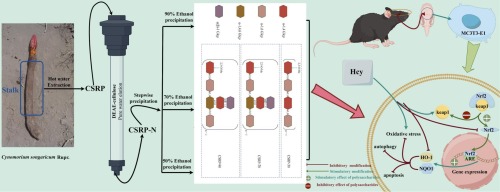Cynomorium songaricum Rupr. is a traditional Chinese medicine renowned for its ability to nourish the kidneys and enhance bone marrow. However, the composition and pharmacological actions of its primary component, polysaccharides, are not fully understood. In this study, three α-glucans (CSRP-50, CSRP-70, and CSRP-90) were isolated from C. songaricum, and their backbones are identical, consisting of repeating units of 1,4-linked α-D-Glcp and 1,6-linked α-D-Glcp. However, CSRP-50 is devoid of side chains, while CSRP-70 and CSRP-90 feature side chains consisting of 1,6-linked α-D-Glcp and terminal 1-linked α(β)-D-Glcp, which are attached at the O-6 position of the 1,4-linked α-D-Glcp in the backbones. Pharmacological studies demonstrated that these three glucans have significant protective effects against homocysteine-induced oxidative stress damage in MC3T3-E1 cells, as indicated by their increased cellular vitality and the levels of glutathione, superoxide dismutase, and total antioxidant capacity, while reducing malondialdehyde and lactate dehydrogenase levels. Further studies have shown that these three glucans can significantly reduce Keap1 expression, while increasing Nrf2, HO-1, and NQO1 expression, and have certain free radical scavenging ability in vitro, suggesting their protective activity via the activation of the Keap1/Nrf2 signalling pathway and directly eliminating free radicals from homocysteine-induced oxidative stress damage in MC3T3-E1 cells.

Graphical abstract
The link below will guide you to the reading:
https://doi.org/10.1016/j.ijbiomac.2025.143344
